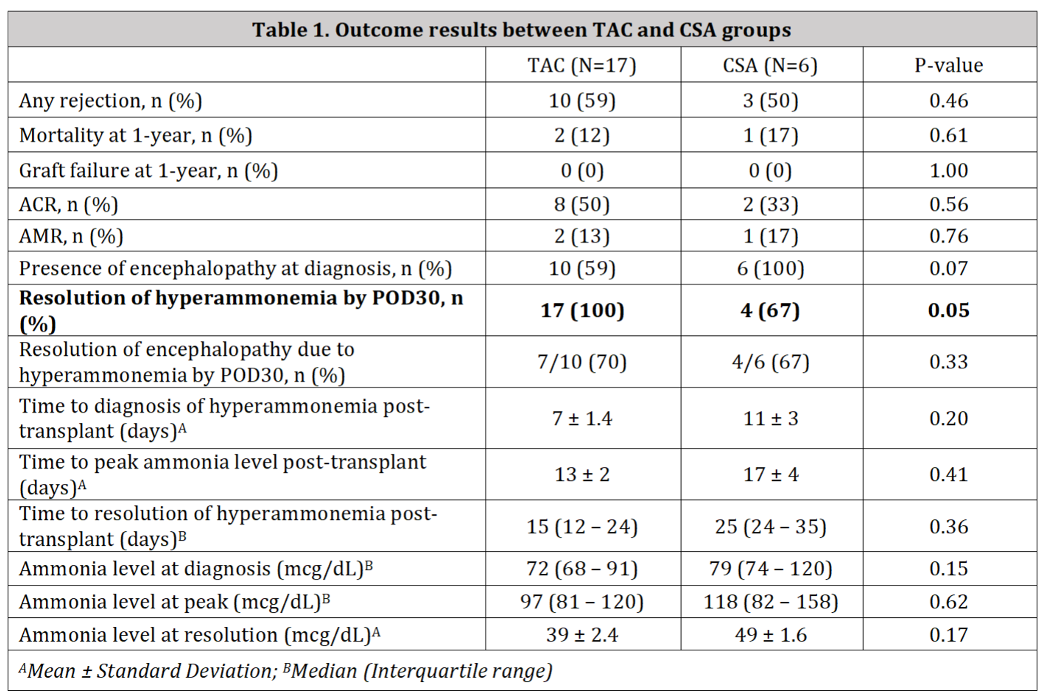Outcomes in Lung Transplant Recipients Switched from Tacrolimus to Cyclosporine Due to Hyperammonemia Early Post-Transplantation
Loyola University Medical Center, Chicago, IL
Meeting: 2022 American Transplant Congress
Abstract number: 1477
Keywords: Immunosuppression, Infection, Lung transplantation, Post-operative complications
Topic: Clinical Science » Lung » 64 - Lung: All Topics
Session Information
Session Time: 7:00pm-8:00pm
 Presentation Time: 7:00pm-8:00pm
Presentation Time: 7:00pm-8:00pm
Location: Hynes Halls C & D
*Purpose: Assess the impact of switching from tacrolimus to cyclosporine due to hyperammonemia on outcomes at 1-year post-lung transplant.
*Methods: A retrospective review of lung transplant recipients (LTR) who developed hyperammonemia within 30-days post-transplant from January 2016 to October 2020 was conducted. Hyperammonemia was defined as ammonia (NH3) >60 mcg/dL with or without encephalopathy and NH3 monitored every 3-days post-transplant, per institution protocol. Outcomes were compared between LTR with hyperammonemia who continued tacrolimus (TAC) and those who were switched from TAC to cyclosporine (CSA). Co-primary endpoints included the incidence of mortality, graft failure (need for re-transplant and/or placed back on extracorporeal membrane oxygenation), and rejection at 1-year. Key secondary outcomes included the incidence of acute cellular rejection (ACR), confirmed or suspected antibody mediated rejection (AMR), presence of encephalopathy at hyperammonemia diagnosis, resolution of hyperammonemia [NH3 <60 mcg/dL post-treatment by post-operative day 30 (POD30)], and resolution of encephalopathy due to hyperammonemia.
*Results: A total of 23 patients were included, 17 in the TAC group vs 6 in the CSA group. Baseline characteristics were similar between groups. There were no graft failure episodes at 1-year post-transplant in either group. There was no difference in any of the co-primary outcomes between groups. The incidence of encephalopathy at the time of hyperammonemia diagnosis was non-significantly higher in the CSA vs TAC group (Table 1). Notably, the resolution of hyperammonemia by POD30 was significantly greater in the TAC vs CSA group (100% vs 67%, P = 0.05).
*Conclusions: To our knowledge, this is the largest study to date assessing hyperammonemia early post-transplant among LTR. Switching from TAC to CSA in patients who develop hyperammonemia found no difference in outcomes at 1-year post-transplant. However, the switch to CSA did not lead to complete resolution of hyperammonemia by POD30 vs those continued on TAC. Although not powered to detect a difference, this finding suggests that conversion to CSA for post-transplant hyperammonemia does not confer an advantage for resolution. Prospective studies are warranted to confirm results and further assess outcomes beyond 1-year.
To cite this abstract in AMA style:
Goyal S, Lyons J, Stracener P, Bemiss B. Outcomes in Lung Transplant Recipients Switched from Tacrolimus to Cyclosporine Due to Hyperammonemia Early Post-Transplantation [abstract]. Am J Transplant. 2022; 22 (suppl 3). https://atcmeetingabstracts.com/abstract/outcomes-in-lung-transplant-recipients-switched-from-tacrolimus-to-cyclosporine-due-to-hyperammonemia-early-post-transplantation/. Accessed December 20, 2025.« Back to 2022 American Transplant Congress

